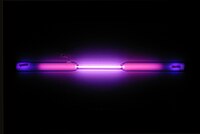
Photo from wikipedia
Abstract This paper reviews the development history of alkali element doping on Cu(In,Ga)Se2 (CIGS) solar cells and summarizes important achievements that have been made in this field. The influences of… Click to show full abstract
Abstract This paper reviews the development history of alkali element doping on Cu(In,Ga)Se2 (CIGS) solar cells and summarizes important achievements that have been made in this field. The influences of incorporation strategies on CIGS absorbers and device performances are also reviewed. By analyzing CIGS surface structure and electronic property variation induced by alkali fluoride (NaF and KF) post-deposition treatment (PDT), we discuss and interpret the following issues: ① The delamination of CIGS thin films induced by Na incorporation facilitates CuInSe2 formation and inhibits Ga during low-temperature co-evaporation processes. ② The mechanisms of carrier density increase due to defect passivation by Na at grain boundaries and the surface. ③ A thinner buffer layer improves the short-circuit current without open-circuit voltage loss. This is attributed not only to better buffer layer coverage in the early stage of the chemical bath deposition process, but also to higher donor defect ( Cd Cu + ) density, which is transferred from the acceptor defect ( V Cu − ) and strengthens the buried homojunction. ④ The KF-PDT-induced lower valence band maximum at the absorber surface reduces the recombination at the absorber/buffer interface, which improves the open-circuit voltage and the fill factor of solar cells.
Journal Title: Engineering
Year Published: 2017
Link to full text (if available)
Share on Social Media: Sign Up to like & get
recommendations!